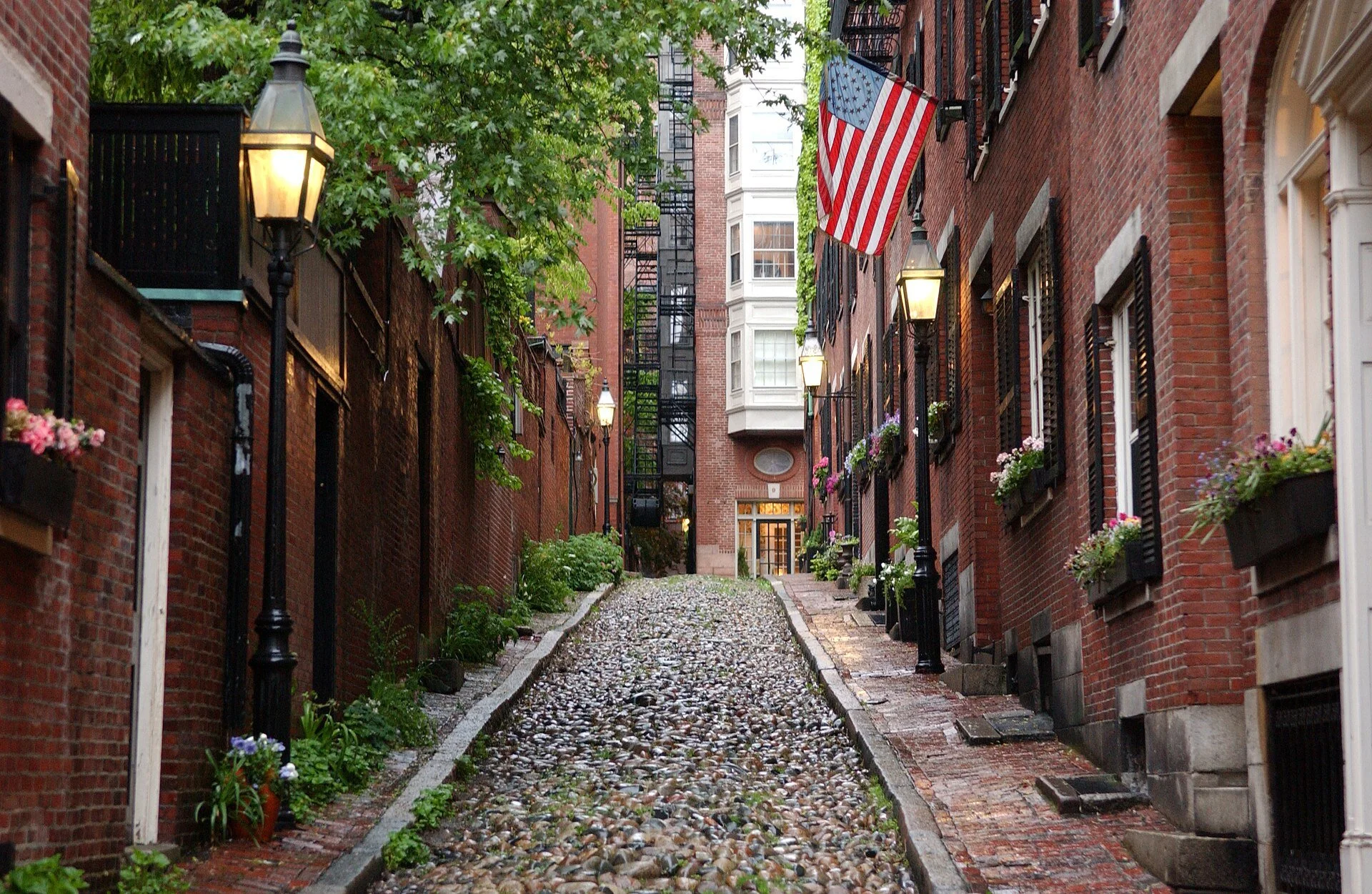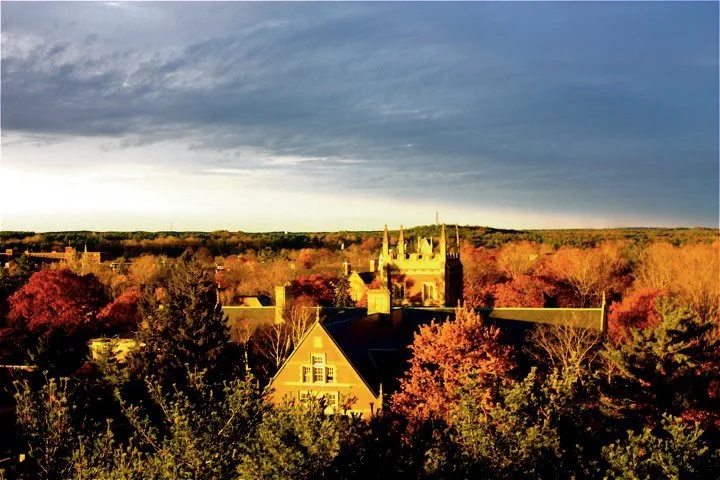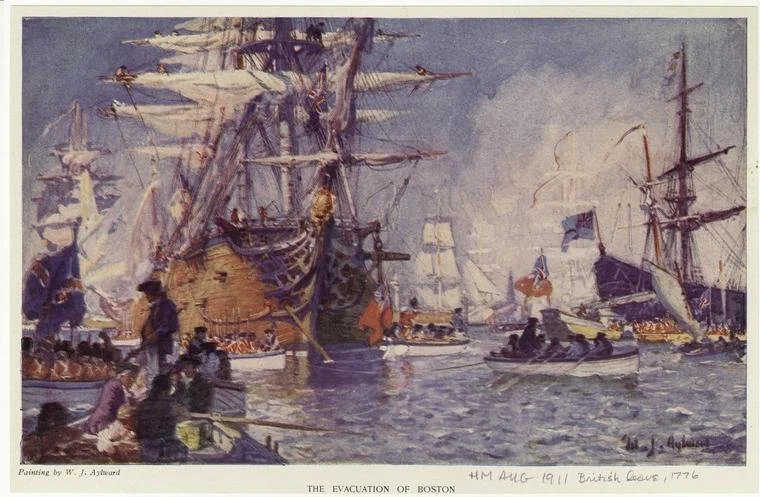Daggett Court: ARCxBuild’s housing triumph
9Daggett Court, in Providence
— Photos by William Morgan
A trio of new townhouses, along with a once three-family home refashioned as a single contemporary residence just off North Main Street in Providence, are significant indicators of what happening to this heretofore neglected neighborhood (the hill between Camp and North Main, Olney and Rochambeau streets).
This small development on Daggett Court is noteworthy on several levels. Aside from the handsome design, this modest settlement tucked between Pleasant and Olney Streets points to a sensible way of adding much-needed housing, sprucing up the mixed area, and offering a more practical and city-affirming alternative to the over-scaled apartment blocks that have so assaulted Providence’s East Side.
12 Daggett Court, north elevation
Number 9 Daggett Court — the photo at the top of this essay and the first phase of this surprising urban oasis, is a 2,100-square-feet single-family home fashioned rising Phoenix-like from a multi-family dwelling. Taking it back to the studs, the architect fashioned a nearly new house with an intriguing triple-gabled skyline that peeks over its shorter neighbors.
Wrapped in vinyl and aluminum siding for reasons of economy, the north elevation looks like a handsome barn, and is rendered in black, one of the currently fashionable colors for new high-end “farm houses” on the East Side.
Realtor Kenneth Scotti’s information sheet declared, “Live the East Side dream in this Modern Masterpiece! Steps from Brown, RISD, and the Providence River waterfront, a brand new, meticulously crafted home designed by RISD alumnus Robert Calise awaits.”
But unlike similarly appointed, multimillion-dollar construction in the currently more desirable parts of the East Side, 9 Daggett sold for the relatively low price of $760,000.
12 Daggett Court, condominiums
The three attached condominiums at 12 Daggett Court continue the peaked-gable theme of the house, with the projecting second-stories. The rhythm of the jagged profile perhaps belies how spacious these units are. Each offers 1,800 square feet of living space, as well as four bedrooms and 2.5 baths; they will list for under $700,000.
The verticality of all of the dwellings on Daggett Court, coupled with the steep slope of the hill, give the homeowners more sunlight and expanded views down to Main Street to the downtown skyline.
9 Daggett Court, entrance.
The real-estate agent’s promotion is also unusual in that it mentions the name of the architect as a selling point. A Cranston native and graduate of the Rhode Island School of Design, Robert Calise Jr., is also the developer. In addition to his academic training and three years of practical work with the Wakefield builders di Stefano Brothers, he credits his father, the insurance agent Robert Calise, as his chief inspiration. The elder Calise is also a developer with a strong interest in design, and together they have worked on this and other projects on Providence Pleasant and Gano Streets.
The younger Calise’s love of Providence and his small-increment approach to rejuvenating neighborhoods is refreshing. He has watched the changes “on the hill” along North Main Street and is convinced that the area can be developed through rehabilitating older houses and by small-scale development.
“Use a little creativity,” Calise says, “to develop postage-stamp-sized lots.” The future is renovation and infill, not massive constructions schemes.
9 Daggett Court, west elevation
The city gave Calise’s firm, ARCxBuild, hassles over parking, forcing the condominium design to go through four major iterations. The architect-developer wanted parking integrated within the structure, as at Number 9, while the city insisted that cars be stabled outdoors. One might think the city would do everything to encourage housing as good as Daggett Court.
By employing existing housing stock and inserting new structures in empty lots these four dwellings offer a rational way forward. The hill along North Main, rather than the Brown, Fox Point, and Wayland neighborhoods, are the logical places to encourage smart growth. In adding new housing in such a thoughtful way, Daggett Court reminds us that small is often better.
William Morgan is an architecture critic, historian and photographer based in Providence. He has taught at Princeton and Brown, and is the author of Academia: Collegiate Architecture in America. His Cape Cod Cottage was published this month.
William Morgan is an architecture critic, historian and photographer based in Providence. He has taught at Princeton and Brown, and is the author of Academia: Collegiate Architecture in America. His Cape Cod Cottage was published this month.
In late March, too
On Nauset Beach (aka The Great Beach) On Cape Cod.
“It is now the middle of March, cold winds stream between earth and the severe assurance of the sun, winter retreats, and for a little season the whole vast world here seems as empty a shell.’’
— Henry Beston (1888-1968) in his 1928 book The Outermost House: A Year of Life on the Great Beach of Cape Cod
We’ll still Need an Extra layer these days
“Blanket for Sharing” (hand woven linen and wool textile, hand felted wool, embroidered linen and wool threads), by Julia Bland, in her show “Liberation Textiles: Our Social Fabric,’’ opening at Concord (Mass.) Art on April 3.
Do Unto others before they can do unto you
James Michael Curley in 1949, in his last term as mayor of “The Hub.’’
“Politics and holiness are not always synonymous. There are times…when, if you wish to win an election, you must first do unto others as they wish to do unto you, but you must do it first.’’
— James Michael Curley (1874-1958) served four terms as Boston famously entertaining and sometimes corrupt mayor. He also served a single term as Massachusets governor and two terms as a congressman.
Edwin O’Connor based the protagonist of his 1956 novel The Last Hurrah on Curley. The movie came out in 1958.
Maurice Cunningham: Astroturf alert! — Rich right-wing Groups, Not ‘grassroots’ folks, are attacking public schools
Plaque on School Street, Boston, commemorating the site of the first Boston Latin School building. Boston Latin was founded in 1635, making it by far America’s first public school.
This article was produced by Our Schools.
Maurice Cunningham PhD, JD, retired in 2021 as an associate professor of political science at the College of Liberal Arts, University of Massachusetts, Boston, and is the author of Dark Money and the Politics of School Privatization.
BOSTON
“If your mother says she loves you, check it out” is a bromide drilled into every journalist. So it is baffling why, if an interest group includes the words “moms” or “parents,” it is just taken at its word, especially when a little digging can reveal that many of these groups are the creations of billionaires out to destroy public education.
As the author of Dark Money and the Politics of School Privatization, I have been following billionaire-backed education interest groups for more than a decade. Since big money lacks public credibility, it often masquerades as organizations claiming to represent the interests of “parents,” “moms,” “educators” and “families.” The concocted stories about how these groups were created are often repeated by an incurious press, which misses the opportunity to tell its readers a more interesting story: how billionaires and right-wing activists pour money into upbeat-sounding organizations to further their aim of privateering our public school system.
These astroturf operations have been proliferating resulting in serious negative impacts. Consider the havoc wreaked on some school boards by Moms for Liberty (M4L). M4L even got into presidential politics in 2024, boosting Donald Trump, at the behest of the donors, who co-founder Tina Descovich termed as M4L’s “investors.”
Consider a November 2024 Washington Post story on Linda McMahon’s nomination to be secretary of education. The article contrasted remarks from National Education Association (NEA) President Becky Pringle with an alternative view from Keri Rodrigues, founding president of the National Parents Union (NPU), which the reporter Laura Meckler called “a grassroots group,” thus giving the impression that NEA and NPU are similar organizations.
They are not. NEA is a well-established teachers’ union that credibly claims 3 million members and is governed by a democratic structure. NPU appeared on the scene in 2020, surfing in on millions of dollars from the foundations of American oligarchs, including the Walton family, Mark Zuckerberg and Charles Koch.
In 2024, Rodrigues, a fixture at education privateering groups, told the Boston Globe that NPU could get its message to “250,000 families to vote against” a ballot question sponsored by the teachers’ union and would “put that network to work.”
There is zero evidence that this extensive network exists or that it did anything on the ballot question. There is also no proof to validate Rodrigues’s claim that the organization has 1.7 million members nationally.
A 2021 Washington Post article introducing Moms for Liberty chronicled its claimed rapid rise without raising questions about how it grew so fast. The story simply provided the M4L narrative of its creation story, centered around former Florida school board members Descovich and Tiffany Justice. It omitted M4L’s third co-founder Bridget Ziegler, though it did quote her husband, Christian Ziegler, about the group’s political potency.
Bridget Ziegler served briefly on the M4L board and was replaced by GOP campaign consultant Marie Rogerson. Christian Ziegler was then the powerful vice-chair of the Florida Republican Party and a key Trump supporter. (In 2023, the Zieglers became famous for a threesome scandal. She quickly resigned from her executive position with the Leadership Institute, an established training institution for right-wing activists. Christian was removed from his perch as chair of the Florida Republican Party.)
The Post October 2021 story featured a photo of Descovich pulling aside, Superman style, a white jacket to reveal the group’s logo t-shirt while posing next to an American flag. The questions about the group’s ties to the Republican Party and suspicious financing were laughed off by the founders of M4L. The Post followed up a month later by printing an op-ed by Descovich and Justice.
NPU, M4L, and similar groups organize as nonprofit corporations under sections 501(c)(3) and 501(c)(4) of the Internal Revenue Service Code. As nonprofits, their Form 990 tax returns are made public but only in November, following the tax year. The information is skimpy but valuable. Journalists can access the Form 990s by requesting them directly from the nonprofits or from the ProPublica Nonprofit Explorer, which helps trace donors as well.
These groups leave clues that no reporter can miss:
1. Don’t buy the phony origin stories: These organizations all claim to be about moms joining together to improve education. But in no time, they have access to millions of dollars in donations and have the services of elite law firms, pollsters, media consultants, and often, ties to the Republican Party.
2. Follow the money: It isn’t easy in the first two years of a nonprofit’s existence, but there are signs: easy access to right-wing media, hiring expensive consultants, and big-budget conferences.
3. Watch how these groups work: The founding leadership usually consists of veteran right-wing operatives or communications professionals with years of experience in privateering organizations.
4. Get the big picture: Right from the beginning, M4L had obvious ties to Republican and right-wing organizations that often went unreported.
5. Keep following the money: When nonprofit tax forms finally become public, they’ll reveal how much was donated and can help identify the top contractors and how much they were paid.
Let us expand on these insights to show how these secretive operations can be exposed right from the beginning by using Form 990.
Don’t Buy the Phony Origin Stories
The typical “moms” or “parents” creation story goes something like this: outraged by some aspect of their children’s public school education, two or three “moms” band together to attract other like-minded parents to cure the deficiencies of the system, which are always the fault of the teachers’ unions. In truth, the “moms” are agents of far-right billionaires often tied—like M4L and Parents Defending Education (PDE)—to the secretive Council for National Policy, which seeks to privateer K-12 for profit, expand Christian education, and promote homeschooling.
According to the billionaire-funded online publication the 74, NPU “is the brainchild of two Latina mothers,” Keri Rodrigues and Alma Marquez, who “had disappointing experiences with education, both as parents and students, and with advocacy groups.”
To its credit, the 74 was candid about the funding of NPU: the foundations of billionaires, including Bill Gates, the Walton family, the late Eli Broad, and Michael and Susan Dell, and organizations like the City Fund, which gets its money from Reed Hastings, John Arnold, and Walton family members, inheritors of the Walmart fortune.
Nonetheless, the tenor of the story was of a grassroots moms’ start-up. Other news outlets ignored the 74’s detailing of billionaire funding. An online search through the New York Times website supplemented with a library search through Gale OneFile showed 13 NYT stories or columns that mention the National Parents Union since the group’s public launch on January 1, 2021. Only one column by Michelle Goldberg noted that “The National Parents Union is funded by the pro-privatization Walton Family Foundation.” The Waltons are, however, the only funders Goldberg mentioned.
The New Yorker came closest to the truth in a June 2021 piece: “The Walton foundation set up the National Parents Union in January 2020, with Rodrigues as the founding president.” A review of Form 990s for NPU and the Walton Family Foundation from 2020 through 2023 that I reviewed shows that NPU accepted more than $11 million in contributions. The Walton Family Foundation donated around $3 million of that amount.
The media are failing to cover the single most important fact the public needs to know about “parents” and “moms” groups: who is supplying them with millions of dollars in funding.
As for M4L, although a few media outlets wrote it had three founders, most followed the practice of CNN, which in December 2021 omitted Bridget Ziegler and described “the two women behind Moms for Liberty, a group of conservatives that came together in January,” downplaying the fact that at that time, the state GOP vice-chair’s wife was also one of the co-founders. By January 9, 2021, soon after its incorporation, M4L’s online store was offering magnets, T-shirts, and hats, and a “Madison Meetup” package of right-wing materials.
While mainstream media were valorizing M4L’s origin story, right-wing outlets produced a steady stream of propaganda about the organization. Later in January 2021, Descovich appeared on the Rush Limbaugh Show (guest-hosted by Todd Herman). Media Matters for America found that, by July 2022, M4L “representatives have been regulars on right-wing media, appearing on Fox News at least 16 times and Steve Bannon’s “War Room” at least 14 times.”
Another supposedly grassroots parents’ group that has an origin story grounded in deception is PDE. In lodging a civil rights complaint against the Columbus, Ohio, public schools in May 2021, PDE President Nicole Neily told the Columbus (Ohio) Dispatch, “We just all work from home… We’re all working moms.”
In fact, Neily is a well-compensated political operative in the Koch network. According to the Koch-connected Speech First’s Form 990 for 2019, which was available after November 2020 and thus before PDE was founded in 2021, Neily was paid $150,000 in 2019.
Follow the Money
Due to the barriers to tracing the funding of such groups, it can be hard to follow the money, especially in the first two years of operation. But in 2021, an article in the New Yorker described how the VELA Education Fund, a partnership of the Walton Family Foundation and the Charles Koch Institute, had given NPU $700,000 in 2020 to “help people with fewer resources,” including promoting homeschooling during COVID-19. This is despite the fact that NPU was not familiar with homeschooling.
Press outlets have also overlooked funding sources of M4L. In 2021, co-founder Descovich told CNN that M4L had raised more than $300,000 through t-shirt sales, small donors, and fundraising events. However, one such event was a gala featuring former Fox News personality Megyn Kelly in June 2021, six months into M4L’s first year. The top tickets went for $20,000. The Celebrity Speakers Bureau pegged Kelly’s speaking fee as between $50,000 and $100,000. The event raised at least $57,000.
In July 2021, Descovich appeared at a Heritage Foundation virtual town hall on “Preserving American History in Schools.” By October 29, 2021, M4L was referring members to the Leadership Institute for training and sending members to the Heritage Foundation for events and other resources. Both these organizations have been part of the right-wing political firmament since the 1970s. A bit of digging showed that M4L was deeply embedded in far-right politics. But most press accounts ignored that evidence and the public remained largely in the dark.
In April 2021, PDE headed by Neily, brought on Elizabeth Schultz as a “senior fellow,” who had worked under Trump’s Education Secretary Betsy DeVos during his first term and was a vocal anti-LGBTQ activist.
Watch How These Groups Work
These groups can be intertwined. PDE, M4L, and another faux-grassroots group, No Left Turn in Education (NLTE), all came on the scene around the same time, with NLTE being founded in 2020. PDE’s website includes a map called “IndoctriNation” with lists of affiliates across the nation. The April 15, 2021, listings (the website appears to have gone live only in March 2021) showed that most of its allies were chapters of M4L and NLTE with few actual members, according to my research in 2021.
Media reports seemed content to accept the “moms working from home” creation story despite the obvious early support from well-resourced groups.
NPU held its organizing meeting, which it claims drew representatives from all 50 states, in New Orleans in January 2020. To promote the event, NPU employed Mercury Public Affairs, an international public relations firm. To draw press attention, NPU also commissioned polling from Echelon Insights, a Republican pollster that has also worked for the Walton family.
In the same year of its founding, in 2021, PDE published detailed plans, such as “How to Create ‘Woke At’ Pages,” that instruct parents on how to use secrecy to attack “woke activists” in the education system. PDE also began initiating lawsuits against local school boards, represented by the Republican law firm of Consovoy McCarthy.
William Consovoy, who died in 2023, was in the Federalist Society, the nationwide network of conservative lawyers that helped form Trump’s picks for the U.S. Supreme Court. Consovoy had been a law clerk to Justice Clarence Thomas and represented Donald Trump during a congressional investigation. The firm also represented Trump in 2020 as he tried to intervene before the Supreme Court to stop the vote count in Pennsylvania. When PDE’s 2021 Form 990 became available, it showed PDE paid Consovoy McCarthy $800,000 in legal fees.
Get the Big Picture
The clues kept coming, only to be ignored by the press.
In 2022, M4L held its first national summit in Tampa, Florida. In its reporting of the event, NBC portrayed the group as a political powerhouse, reporting that attendees “browsed booths set up by conservative groups, including Turning Point USA, the Leadership Institute and Heritage Action, and the evangelical Liberty University” without describing these organizations for what they are—the critical infrastructure of Christian nationalism.
Media reports on the event generally ignored who the sponsors of the summit were or the amounts of their donations. The Leadership Institute donated $50,000. The Heritage Foundation and Heritage Action for America provided $10,000 each. And PDE chipped in $10,000. Meanwhile, Descovich was still peddling the story that M4L was getting by on t-shirt sales, even though an aide to Leadership Institute’s Morton Blackwell bragged about how the institute had provided the relevant training to help the group “become a national force.”
When there were questions raised about how M4L could fund such a lavish event with T-shirt sales, M4L denied any connections to deep-pocketed right-wing groups, and most news reporters presented a simple “he said, she said” account and moved on. Reporters generally missed the bigger story that the institutional right was creating and passing off phony “moms” and “parents” operations.
Keep Following the Money
Once Form 990s were filed, the deception became obvious, but that didn’t mean it got covered by big media outlets.
The 2022 Form 990 for NPU showed that Keri Rodrigues was paid $410,000 from NPU and a sister organization. She paid her husband, the chief operating officer of both organizations, $278,529. Yet, in August 2024, CBS Morning News presented Rodrigues as a typical parent worried about back-to-school shopping.
PDE’s Form 990 for 2021 was even more revealing, as exposed by True North Research’s Lisa Graves and Alyssa Bowen for Truthout in 2023. Graves and Bowen showed that PDE is deeply tied with far-right Supreme Court fixer Leonard Leo, even paying $106,938 to his for-profit consulting firm.
PDE, a brand-new operation, raised $3,178,272 in its first year in 2021. It paid Neily, who is also on the board, a total compensation of $195,688 for her 40-hour work week.
According to Speech First’s Form 990 for 2021, Neily put in an additional 20-hour week for Speech First, earning another $86,117 and a total of $281,805 from both Koch- and Leo-funded operations combined. In 2023, PDE pushed Neily’s base salary and other compensation up to $341,400. This is quite an income for a stay-at-home working mom.
The trail from NPU leads back to the Walton family and billionaire allies who have been working to undermine teachers’ unions and siphon public money to charter schools for years.
Scratch the surface of groups like M4L and PDE, and you find the Heritage Foundation, the Leadership Institute, and Leonard Leo—the elite of far-right politics who work to replace public schools with for-profit schools, religious schools, and homeschooling. These details make for a very important story that most journalists have overlooked.
Stop Being Fooled
Reporters should not be fooled by the techniques used by these fake “mom” and “parent” groups on behalf of their extremist overseers. As Naomi Oreskes and Erik M. Conway show in Merchants of Doubt: How a Handful of Scientists Obscured the Truth on Issues from Tobacco Smoke to Global Warming, these techniques have been used by “scientific” nonprofits created by the same conservative groups, including the Heritage Foundation, to contest climate change.
Many have tracked the origin of these techniques back to the tobacco industry’s fight to protect their profits from the growing body of research linking their products to cancer and other health problems.
In 1994, tobacco giant RJ Reynolds created the industry front group Get Government Off Our Back to advance a “smokers’ rights” campaign to fight against the tsunami of scientific evidence exposing the health risks of tobacco. Reynolds kept its backing a secret while promoting it as a movement of “grassroots” smokers.
Meanwhile, in his farewell address, former President Joseph R. Biden warned about how the wealthy are a big threat to democracy:
“Today, an oligarchy is taking shape in America of extreme wealth, power, and influence that literally threatens our entire democracy, our basic rights and freedoms, and a fair shot for everyone to get ahead.”
For years, the same oligarchy that threatens basic rights has been threatening our freedom to have access to a high-quality system of public education. There is no reason they should be aided by credulous reporters from trusted news sources. If we can question our moms on whether they really love us, we can question the authenticity of these moms and parent groups.
‘Behind material culture’
Objects from the installation “The Thief, the Spinner and the Fabulis,” opening April 10 at Mad River Arts, Waitsfield, Vt.
An edited version of the gallery’s statement:
“This exhibition embraces the stories behind material culture and examines the physical object whether as art, gift, ‘symbolic other’ or that which is used by us. The exhibition is a means to understand who we are through what we collect and how ‘physical things’ interact in our lives.
“We’ll curate inanimate objects that our community has loaned to us and will use the composition and symbolism that the still life genre conveys. This installation will be the tool for storytelling about the ‘physical world’ in our community.’’
Chris Powell: Sanctimony city and state milk grim history for patronage
A 1743 copy of the Treaty of Hartford of 1638, which sought to eradicate the Pequot cultural identity by prohibiting the Pequots from returning to their lands, speaking their tribal language, or referring to themselves as Pequots.
The nave of Trinity Church, on the New Haven Green. The Gothic Revival building was constructed in 1814-1816.
MANCHESTER, Conn.
Two more tedious but true tales from the Sanctimony City and the Sanctimony State have unfolded.
In New Haven dozens of people gathered at Trinity Church on the city's green on March 8 to mark the 200th anniversary of the last recorded sale of slaves in the city and Connecticut -- two women who were paraded to the green and purchased by an abolitionist who eventually set them free. Last week's gathering called itself a “service of lamentation and healing."
Meanwhile, at the state Capitol, a legislative committee considered a resolution to condemn the Treaty of Hartford of 1638, which marked the end of the war between the Pequot Indian tribe and its adversaries -- the English, Mohegan and Narragansett tribes. The war killed most of the Pequots and the treaty sought to nullify the few who were left, bestowing them on their adversaries as slaves and prohibiting the tribe's reconstitution.
The events implied that modern society bears some enduring guilt for the abominations of centuries past. Indeed, establishing this guilt seems to have been the political objective. This was mistaken and ironic.
Americans like to believe in their country's exceptionalism, but slavery was and remains a worldwide phenomenon going back millennia and transcending nations and races. The slaves brought to the United States and delivered to white masters had been sold first in west Africa by other Black people. To some extent slavery continues today in Africa, the Middle East, and Asia.
So in the larger context Connecticut's connection to slavery may be more remarkable for the efforts to overthrow it than to sustain it. In any case in no country was there a more devastating war to destroy slavery than what happened in the United States.
But even as New Haveners gathered to “lament" and “heal" from the wrongs of two centuries ago, the city remained the scene of a devastating wrong for which no sanctimonious services of lamentation and healing are ever held. That is, most of the city's children -- members of racial and ethnic minorities, far more numerous than there were ever slaves in the state -- lack parents, live in poverty, and fail in school.
New Haven's schools have the worst chronic absenteeism in the state and many of those schools are in terrible repair. Many of their students, undereducated and demoralized, graduate to a more subtle but far more prevalent form of slavery.
As for the Indian wars of almost four centuries ago, they were full of atrocities, though today it is politically correct to remember only those of the winning side.
The massacre of the Pequots in May 1637 in what is now Groton was the most horrible thing ever to happen in Connecticut. But the Pequots started the war. The tribe's very name meant “destroyers" and they already had made deadly enemies of the Mohegans and Narragansetts long before attacking the English settlement in Wethersfield in April 1637, killing nine unarmed people, including three women, kidnapping two women, and killing the settlement's cattle.
So a month later the English, Mohegans and Narragansetts united in a conclusive slaughter.
While the Treaty of Hartford fairly can be called genocidal, it was itself a response to genocide in an era when genocide was common.
No morality is taught by the sanctimony that evoked these horrors last week. Slavery has had no constituency in Connecticut since those last slaves were sold in 1825. Nor is there any constituency here for genocide, though in modern war civilians are often killed.
But there is a selfish political constituency for mobilizing the horrors of the past.
Sanctimoniously reminding people of slavery can intimidate them out of opposing the claims of racial minorities for more government patronage, though that patronage isn't righting any wrongs.
And sanctimoniously reminding people of the Treaty of Hartford may insulate the absurd patronage enshrined in state law whereby the ultra-distant descendants of the ancient Pequots, the victims of genocide, share a casino duopoly with the ultra-distant descendants of the ancient Mohegans, that genocide's co-perpetrators.
Chris Powell has written about Connecticut government and politics for many years (CPowell@cox.net).
Trump’s assaults make Quebecers feel more Canadian
The Quebec Parliament Building in Quebec City
Tony Webster photo
From The Conversation, except for images above and at bottom.
Yulia Bosworth is a professor of French and Linguistics, at Binghamton University, State University of New York
Yulia Bosworth does not work for, consult, own shares in or receive funding from any company or organization that would benefit from this article, and has disclosed no relevant affiliations beyond their academic appointment.
As Canadians rally around national unity in response to American tariffs and threats of annexation, kindling a renewed sense of Canadian nationalism, Québec stands in solidarity with the rest of Canada.
A February Angus Reid survey suggests a notable increase in Québecers’ emotional attachment to Canada and in their pride in being a Canadian. Those numbers increased by 15 and 13 percentage points to 45 and 58 per cent, respectively, compared to the findings in a similar poll conducted in December 2024.
A more recent Angus Reid poll has found Québec is the most anti-Donald Trump province in Canada.
Québec has joined the rest of Canada in mounting a strong economic response in the trade war. Premier François Legault has supported boycotting American products and buying local, diversifying exports and reducing barriers to inter-provincial trade.
With 41 percent of Québecers responding that they are less likely to travel to the U.S., the province trails just slightly behind the 48 per cent share of Canadians with the same intentions, according to a Leger poll.
Québec’s distinct identity
In light of these expressions of unity, outgoing Prime Minister Justin Trudeau’s contention that Canadians “are more united than ever” resonates with many in Canada and beyond. His replacement as leader, Mark Carney, told Canadians in his victory speech that Trump is “attacking Canadian workers, families and businesses and we cannot let him succeed …. When we are united, we are Canada strong.”
Québec, however, with its distinct identity within Canada anchored in the French language and a unique culture, faces particular challenges and priorities amid the current crisis.
As a sociolinguist and a discourse analyst with broad expertise in Québec studies, I focus on Québec identity and its distinctiveness within Canada. I am particularly interested in how it is constructed and expressed in public discourse, especially in the media and the political sphere.
Canadian identity had not been a prominent topic of national conversation for some time. In contrast, Québec identity has long been a key topic of public discourse, maintained and fuelled by the province’s media.
As Canadian society re-engages in defining its collective identity, it is especially timely to clarify what defines Québec identity and how the province is grappling with the current crisis.
My work analyzing identity-related public discourse has consistently shown that Québec remains committed to its own vision of identity and belonging. This vision is distinct from the Canadian approach, which is based on multiculturalism and bilingualism.
Interculturalism
In contrast to Canadian multiculturalism, which does not recognize a national or a majority culture, Québec adheres to a model for managing cultural diversity known as interculturalism. Its overarching objective is to reconcile diversity with a national culture rooted in the French language.
Crucially, under interculturalism, the culture of the French-Canadian majority is no longer considered the defining element of Québec identity. Instead, Québecers of all backgrounds are called on to participate in a common civic culture. In this model, the French language serves as the common public language of civic engagement.
When national identity is anchored in a common culture, the link between them becomes vital. When one is threatened, so is the other. Conversely, reinforcing one is likely to strengthen the other.
The Québec state supports and promotes the French language and Québec culture as pillars of Québec identity.
But both English-speaking Canada and French-speaking Canada share the long-standing challenge of resisting Anglo-American cultural domination in order to maintain a distinct cultural identity.
In Québec, where language and culture are central to identity, the risk of annexation into the Anglo-American cultural sphere, or of more tariff-driven cuts to the already underfunded cultural sector, puts Québec identity in serious jeopardy.
Ties between culture and economics
This can help explain why, in addressing the looming economic crisis, Legault has vowed to protect Québec’s language, values and identity.
Economy and culture are deeply interconnected in the province — a coalition of regional arts festivals, for example, has called for an end to directing funds toward U.S.-based companies involved in organizing cultural events in the province.
The Canadian hockey team’s recent win in the 4 Nations Face-off inspired an enthusiastic display of national pride by fans across the country, including in Québec.
The Québec government is in fact working on legislation that would recognize ice hockey as the province’s official sport, another display of the shared passions between Québec and the rest of the country.
The rallying around Canadian identity, sparked by the threat of Trump’s tariffs and annexation, appears to be bringing Québec and the rest of Canada closer together. If so, is this rapprochement stemming from a heightened awareness of shared priorities, or from a growing mutual respect for the distinct ones? The coming weeks and months should provide the answers.
The humble U.S.-Quebec border crossing at Canaan, Vt., before entering Hereford, Quebec. The once-relaxed border has become more tense since Trump regained power.
Performance anxiety
“Backstage” (oil on panel), by Jessica Gandolf, in her show “No Assembly Required,’’ at Moss Galleries, Falmouth, Maine, through April 5.
She says:
“Painting helps organize my thinking, my energy and my perceptions in a way that nothing else does. Seeing art has always made me want to make it. Creating art is a way of making sense of things, of saying something meaningful without words. Sometimes I seem to be calling attention to something at the edge of consciousness or dredging up something long buried. This can happen by making pictures or without using recognizable imagery. Sometimes it feels like magic is involved when uniting the physical presence of paint with the realm of the spirit -- magic born of some combination of anxiety and doggedness, open heartedness and luck.’’
Casco Bay from Falmouth in 191o.
A literary Hill
Window boxes on cobblestoned Acorn Street on Beacon Hill.
— Photo by Ian Howard
(Robert Whitcomb, New England Diary’s editor, is chairman of The Guardian. He edited but did not write this article.)
The imagery of Boston’s charming gas-lit streets and brownstone and brick Federal-style buildings have provided inspiration and residence to some of the most celebrated writers in American literature.
Beacon Hill, in particular, has been an historic home for greats, such as Louisa May Alcott, author of Little Women, and Nathaniel Hawthorne, author of The Scarlet Letter.
The neighborhood has been a source of vivid ink to others, such as Henry David Thoreau, who lived there in his childhood, and Robert Frost, who taught at Harvard University and other schools.
The loosely autobiographical Little Women, by Alcott, is a coming-of-age story about the overlap of childhood and young adulthood, a too swift liminal space where children want to be grown but are hesitant to grow up.
Alcott spent a considerable part of her early life in Boston from 1834 to 1840 before her family settled in Concord. However, she later returned to the city and lived on Beacon Hill in the early 1850s while working as a writer and a social reformer.
Her first published works, The Rival Painters: a Tale of Rome and Flower Fables were both published while she was living at 20 Pinckney Street. Her work as a women’s suffrage activist on Beacon Hill empowered her female characters with agency and self-determination.
Hawthorne, author of The Scarlet Letter, wrote love letters to his future wife from his home at 54 Pinckney Street while working at the Boston Custom House in the 1840s. Before that, he paid for room and board to the poet Thomas Green Fessenden on Hancock Street. He would later say of this period of his life, “I have not lived, but only dreamed about living.”
The heroine of his well-known novel grows beyond her longheld ideals after her Puritan community shuns her into isolation. Through protagonists that develop strong, individualistic approaches to the world,
Hawthorne and Alcott reflected the development of thoughts and views throughout a young adulthood which was spent in large part on Beacon Hill.
Many other authors and poets would have their brushes with Beacon Hill and Boston’s literary influence as well.
Henry James, renowned for the psychological depth of his approach to social complexities, lived at 102 Mount Vernon Street in the 1860s before moving to Europe. His time in Boston exposed him to the evolving nature of American society, a theme that permeates many of his works.
In the 20th Century, Beacon Hill continued to attract literary minds, including Sylvia Plath.
The renowned poet and novelist lived at 9 Willow Street while attending classes at Boston University and working at Massachusetts General Hospital. During her time on Beacon Hill, Plath was mentored by poet Robert Lowell and befriended fellow poet Anne Sexton. The city’s atmosphere and her personal experiences deeply influenced her work, particularly her novel The Bell Jar, which captures the struggles of a young woman navigating mental illness and societal expectations. The history of Beacon Hill is a testament to Boston’s enduring influence as a center of American literature.
These writers, among others, found inspiration in the city’s history, its people and its intellectual climate. Walking through the streets of Beacon Hill today, one can still feel the echoes of these literary greats, their presence lingering in the historic architecture and timeless charm.
Closing in on it
From the Norman B. Leventhal Map & Education Center, at the Boston Public Library:
“This {1785} map was the first American wall map, and among the most important early maps published in the United States. Due to a chronic lack of trained surveyors, engravers and printers in post-Revolutionary War America, very few maps of any kind were published before 1790.
“Using information from several earlier maps and coastal charts published in England, this map of the four New England states -- Massachusetts (including Maine counties), New Hampshire (including Vermont counties), Rhode Island, and Connecticut -- added substantial new information in the northern portions of the map, particularly for the New Hampshire townships and Maine's coastal area.
Creator:
Contributor:
Editor’s note: The big border vagueness at the top of Maine and New Hampshire was cleared up with Secretary of State Daniel Webster’s 1842 negotiations with the United Kingdom.
Childhood’s light and Dark
“Shadows” (archival inkjet print), by Anastasia Sierra, at the Cambridge Art Association.
Martin Abel/Reed Johnson: Is this a Bad sign for Human creativity?
From The Conversation, except for images at the top and bottom
Martin Abel is an assistant professor of economics at Bowdoin College. Reed Johnson is a senior lecturer in Russian, East European and Eurasian Studies at Bowdoin.
An artificial neural network is an interconnected group of nodes, akin to the vast network of neurons in the human brain.
The authors do not work for, consult, own shares in or receive funding from any company or organization that would benefit from this article, and have disclosed no relevant affiliations beyond their academic appointment.
People say that they prefer a short story written by a human over one composed by artificial intelligence, yet most still invest the same amount of time and money reading both stories regardless of whether it is labeled as AI-generated.
That was the main finding of a study we conducted recently to test whether this preference of humans over AI in creative works actually translates into consumer behavior. Amid the coming avalanche of AI-generated work, it is a question of real livelihoods for the millions of people worldwide employed in creative industries.
To investigate, we asked OpenAI’s ChatGPT 4 to generate a short story in the style of the critically acclaimed fiction author Jason Brown. We then recruited a nationally representative sample of over 650 people and offered participants $3.50 each to read and assess the AI-generated story. Crucially, only half the participants were told that the story was written by AI, while the other half was misled into believing it was the work of Jason Brown.
After reading the first half of the AI-generated story, participants were asked to rate the quality of the work along various dimensions, such as whether they found it predictable, emotionally engaging, evocative and so on.
We also measured participants’ willingness to pay in order to read to the end of the story in two ways: how much of their study compensation they’d be willing to give up, and how much time they’d agree to spend transcribing some text we gave them.
So, were there differences between the two groups? The short answer: yes. But a closer analysis reveals some startling results.
To begin with, the group that knew the story was AI-generated had a much more negative assessment of the work, rating it more harshly on dimensions like predictability, authenticity and how evocative it is. These results are largely in keeping with a nascent but growing body of research that shows bias against AI in such areas as visual art, music and poetry.
Nonetheless, participants were ready to spend the same amount of money and time to finish reading the story whether or not it was labeled as AI. Participants also did not spend less time on average actually reading the AI-labeled story.
When asked afterward, almost 40 percent of participants said they would have paid less if the same story was written by AI versus a human, highlighting that many are not aware of the discrepancies between their subjective assessments and actual choices.
Why it matters
Our findings challenge past studies showing people favor human-produced works over AI-generated ones. At the very least, this research doesn’t appear to be a reliable indicator of people’s willingness to pay for human-created art.
The potential implications for the future of human-created work are profound, especially in market conditions in which AI-generated work can be orders of magnitude cheaper to produce.
Even though artificial intelligence is still in its infancy, AI-made books are already flooding the market, recently prompting the authors guild to instate its own labeling guidelines.
Our research raises questions whether these labels are effective in stemming the tide.
What’s next
Attitudes toward AI are still forming. Future research could investigate whether there will be a backlash against AI-generated creative works, especially if people witness mass layoffs. After all, similar shifts occurred in the wake of mass industrialization, such as the arts and crafts movement in the late 19th Century, which emerged as a response to the growing automation of labor.
A related question is whether the market will segment, where some consumers will be willing to pay more based on the process of creation, while others may be interested only in the product.
Regardless of how these scenarios play out, our findings indicate that the road ahead for human creative labor might be more uphill than previous research suggested. At the very least, while consumers may hold beliefs about the intrinsic value of human labor, many seem unwilling to put their money where their beliefs are.
View of the Bowdoin campus from Coles Tower.
Photo by Polarbear 11
To get me Out
“Chasing The Horizon” (acrylic, ink, fake fur, cotton on wood panel), by Yeon Ji Yoo, in the show “Wish You Were Here,’’ opening March 22 at the Brattleboro (Vt.) Museum & Art Center.T
Brutal!
Part of the University of Massachusetts at Dartmouth campus, which was designed by Paul Rudolph.
Boston City Hall, designed by Michael McKinnell and Gerhard Kallmann
Photo by andrewjsan - https://www.flickr.com/photos/andrewsan/6776358460/
Adapted from an item in Robert Whitcomb’s “Digital Diary,’’ in GoLocal24.com
The Brutalist, the epic movie about an immigrant architect and Holocaust survivor, has aroused a lot of interest in “Brutalist” architecture, whose heyday was from the 1950’s to the early ‘70s. It’s characterized by minimalist and bulky constructions displaying bare materials, most notably exposed and unpainted concrete or brick, angular shapes and little if any decoration. Brutalism, with its cheap materials and speed of building, was particularly attractive to those rebuilding Europe’s bombed-out cities after World War II.
When I think back to what I walked by in various cities back then, those then-new gray and hulking creations, some with pipes and other utilities exposed, often come to mind.
Some of these buildings are, or were when they went up, quite exciting, even Boston’s famous or infamous city hall, which went up in 1968, or the campus of the University of Massachusetts at Dartmouth, built in the mid and late ’60s. But more people consider them dystopian than beautiful. They also tend to leak! And a big problem is that concrete walls don’t age well, especially in damp climates such as New England’s. The concrete tends to collect dirt and stain, and its heaviness weighs on our spirits. Of course, granite, marble and other rock walls look heavy, too, but they can be very beautiful, if expensive.
Most people want some texture, charm and warmth in their built environments – say with weathered brick and wood, seasoned with sometimes quirky decoration, some of it criminally cute. They want to be comforted by the built environments they live amongst. That isn’t to say that they can’t see the beauty in such gorgeous glassy, glittery Modernist (but not Brutalist) creations as the John Hancock Tower in Boston or New York’s Seagram Building and Lever House. (I loved to look at them by day or night when I worked in New York in the ‘70’s.)
In any event, Brutalism has had its run, which all in all is a good thing, though some of the “Post-Modernist’’ architecture that has succeeded it since the 80’s is hackneyed, with pastiches of various styles, newish and ancient, looking glued together.
A stripped-down Post-Modernist building at Dartmouth College, in Hanover, N.H. Completed in 2002, it was designed by Venturi, Scott Brown and Associates, Inc. in association with Shepley Bulfinch Richardson and Abbott. Its style references Georgian architecture, the dominant look of buildings on the campus.
AKA St. Patrick’s Day
The evacuation of Boston by the British, on March 17, 1776. That, and not St. Patrick, is why it’s an official holiday in Suffolk County, Mass.
— Painting by William James Aylward
Is it your Servant or Master?
P.T. Barnum
“Money is in some respects like fire; it is a very excellent servant but a terrible master. When you have it mastering you; when interest is constantly piling up against you, it will keep you down in the worst kind of slavery. But let money work for you, and you have the most devoted servant in the world.’’
— P.T. Barnum, (1810-1891), of Bridgeport, Conn. (where he served as mayor), American showman and politician famous for promoting celebrated hoaxes and founding with James Anthony Bailey what became known as the Ringling Bros. and Barnum & Bailey Circus. He was also an author, publisher and philanthropist, but said of himself: “I am a showman by profession ... and all the gilding shall make nothing else of me."
‘between hand-made and mass-Produced’
“Snulpture #4” (welded steel, fabric, audio and kinetic electronics), by Andrew Zimmerman, in his show “Snulpture,’’ at Boston Sculptors Gallery, opening April 3.
He says:
“In my work I am interested exploring the intersection between painting and sculpture, art and design, the hand-made and the mass-produced. I am excited by the tension that arises from situating my work in between these categories. I would like my paintings to create moments of unexpected discovery within a language of reconstructable forms.
“I fondly remember working with my dad in his wood shop as a young child. Cutting the parts and assembling the pieces into a bench or a table revealed to me a magical journey from a slab of wood to a finished product. More importantly, I experienced the joy and endless possibilities of making things by hand.’’
Colors Begin Spring Offensive
“Pastel Shades of Pale” (oil & cold wax), by Angel Dean, at the Providence Art Club’s “Winter 2025 Members’ Exhibition,’’ through March 27.
“l’ll see you again whenever spring breaks through again.’’
Old-fashioned, sugary romance
No hourly rates though
‘‘The Siesta,’’ by Janet Montecalvo, in the Duxbury Art Association’s “Winter Juried Show,’’ at the Art Complex Museum, Duxbury, Mass., through April 19.
































